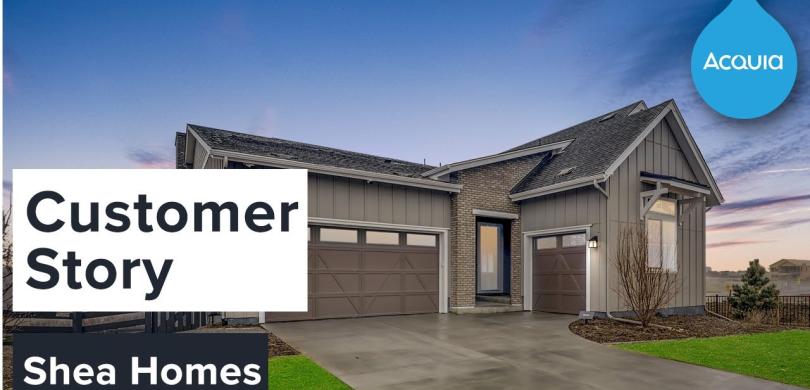
Shea Homes
Acquia DAM (Widen), including the Assets and Insights applications, and integrations.

embed views in the last 12 months
total assets
asset downloads in the last 12 months
The Client
Founded in 1968, Shea Homes is one of the largest private homebuilders in the nation and has built more than 115,000 homes across the United States.

The Situation
The marketing team at Shea Homes produces a range of visual content to promote and sell their homes, including photography, videos, brochures, renderings, floor plans, and more.
The Challenge
Without a digital asset management (DAM) system, they lacked a centralized location to store and manage their visual content. In addition, the workflow to publish and manage this content on their website was manual and time-consuming.
The Solution
The Shea Homes team addressed these challenges by investing in both Acquia DAM and a new content management system (CMS) — and then integrating these solutions using the Acquia DAM API.
A central source of truth
The first step in Shea Homes’ software integration strategy was to establish Acquia DAM as the repository for all content. “Gated content, brochures, floorplans, everything that's developed goes into [Acquia DAM],” said Meridith Doucette, National Vice President of Digital Strategy at Shea Homes.
This ensures that all internal and external stakeholders know where to find approved and current assets. “Those images are getting pulled into presentations with division presidents when we go to land deals, so it's really grown from just sales and marketing.”
This centralized approach also provides a consistent and reliable foundation for publishing content online. “If an image isn’t in the DAM system but it's broken on the website, how do we find it? It’s really important to us that any images that are on the website are in [Acquia DAM].”
In addition, Acquia DAM’s flexible metadata capabilities, including expiration dates, allows the Shea Homes marketing team to control the use of licensed content. “We've worked with photographers where their licensing structure was an annual renewal…[Acquia DAM]allows us to expire any photos that can't be used,” Meridith explained. And by using metadata to capture if the image is used online, they know to replace it to avoid broken links.
Dynamic file resizing
Before the integration between Acquia DAM and their CMS, Kentico, publishing content online entailed resizing images to fit the dimensions of specific webpage modules. Meridith explained that if an image appeared on three pages in different sizes, “users would have to size each image three times, and upload it three times to each spot. Now they don't have to do that. They can use the same image over and over again, and it will resize as it should.”
With the help of a custom integration using the Acquia DAM API, the images are dynamically scaled to the appropriate format. She explained, “Normally, when you click ‘add photo’ you are prompted to search for a picture on your hard drive or somewhere else. And that's what we've overwritten.” Now the user is able to search for an image directly in the Acquia DAM system. They can filter their results using metadata, and once an image is selected, it is automatically displayed in Kentico at the appropriate size.
This automated workflow eliminates the need to create and store multiple versions of the same image — or to download these files from one system and upload them to another.
Embed codes
Another essential aspect of their DAM and CMS integration is the use of embed codes, or asset-specific HTML that displays files online. Whenever an asset is updated in the DAM system, the new version is automatically published everywhere it’s embedded.
Shea uses embed codes to distribute images, videos, and downloadable content across their digital channels, including their website, emails, and QR codes. “Every digital image is hosted in [Acquia DAM] and embedded in whatever materials we are using,” Meridith shared.
This approach avoids the need to store files in Kentico, ensuring that only the most current version from the DAM system exists online and creating consistency across their digital experience.
The Results
Empowered users
Meridith points to time savings as the most significant benefit Shea Homes has realized by using Acquia DAM. For example, their workflow to create presentations has been dramatically simplified through self-serve access to project imagery. She shared that before they had Acquia DAM, the marketing team would spend hours searching for and sharing images to help teams prepare for the company’s annual business meeting. Now, this process takes minutes. “They would be scrambling to get all of the pictures, because they were all on their hard drives. And now that question doesn't even need to be asked. You can go into [Acquia DAM] and you search by when things were uploaded and find all of the pictures — and it's easy.”
Accelerated digital workflows
Their integrated approach to DAM and CMS has also created valuable time-saving efficiencies. “With the combination of [Acquia DAM] and our new CMS, I can build a landing page in 10 minutes. If I write the copy, I can find the images I need and they are all sized properly,” Meridith shared. “It's been a huge time savings.”
This simplified workflow allows Meridith’s team to spend less time on manual tasks — and more time on strategic work.
Foundation for additional integrations
In addition, the success of their integration between Acquia DAM and Kentico has encouraged Meridith’s team to explore other ways to use the API to sync content across their marketing technology (martech) stack.
They are currently considering an integration with Salesforce, to give their sales teams an easy way to upload content into the DAM system within the software they often use. This content will then be used to help power their digital experience. “When salespeople go out and take pictures of customers’ homes, they need a place to upload them quickly and easily. They use Salesforce, so we're giving them a place in their tool to upload the photos with just a few clicks.”
